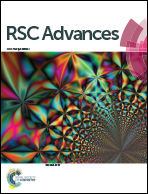Cuprous oxide microspheres on graphene nanosheets: an enhanced material for non-enzymatic electrochemical detection of H2O2 and glucose
Abstract
We report here a facile one-step green synthesis of cuprous oxide microspheres (Cu2OMS) on reduced graphene oxide (RGO) by reducing Cu2+ ions and GO with sodium ascorbate synchronously in the presence of sodium hydroxide. Cu2OMS with different sizes on the surface of RGO were successfully synthesized by adjusting the mass ratio of GO to CuSO4·5H2O in this reaction system. It was found that uniform Cu2OMS were formed on RGO by increasing the mass ratio from 1 : 20 to 1 : 80. The synthesized Cu2OMS–RGO composites with different structures were immobilized onto glassy carbon electrodes and applied to construct electrochemical hydrogen peroxide (H2O2) and glucose sensors. The results indicate that the Cu2OMS–RGO composite created with the mass ratio of 1 : 80 presents the best sensor performances. The fabricated H2O2 sensor exhibits a fast amperometric response to H2O2 with a linear detection range from 0.005 to 2.775 mM and a detection limit of 0.0108 mM, and the glucose sensor has a linear detection range from 0.001 to 0.419 mM and a detection limit of 7.288 × 10−4 mM. The superior performance is ascribed to the unique structure of the synthesized Cu2OMS and the excellent conductivity of the RGO content. In addition, the synthesized Cu2OMS–RGO composites exhibited improved electrochemical stability. Such novel Cu2OMS–RGO hybrid materials represent promising non-enzymatic electrochemical glucose and H2O2 sensors with high sensitivity and selectivity, improved stability, and fast amperometric response.


 Please wait while we load your content...
Please wait while we load your content...